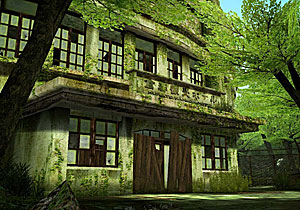The third video game is Fragile Dreams: Farewell Ruins of the Moon. As with Hellgate and Fallout 3, I’ll start with the video, make a few observations about that video, and then follow up with some thoughts based on preliminary chasing up of material online.
The following is a trailer is for the upcoming US release:
And here’s the same trailer, but with Japanese voice acting:
I’ll put my cards on the table: I’m really cheating with Fragile Dreams, as I don’t think it’s set in any one (or more) real cities. It appears to be a generic contemporary ruin — a sort of “Every-city.” Despite this, of all the video game footage that I’ve seen, this is the one that comes closest to the thoughtfulness, melancholy, and feelings of loss that we traditionally associate with the contemplation of ruins.
Note that the trailer’s opening is loaded with representations of communications technology. Abandoned railway tracks feature early and prominently. I was immediately convinced that the “red tower” (given as a destination in the first ten seconds, possibly represented as a drawing at 0:17, and possibly actually appearing at 0:47) is some kind of radio mast. And the crude drawings (0:17) that we see are oddly reminiscent of prehistoric cave art.
As the trailer stresses loneliness and isolation in a post-apocalyptic world and sets a goal of finding other people, it’s unlikely that this foregrounding of communication technology is accidental. The railway tracks point to the networks of communications and transportation in place since the nineteenth century, the tower to the ultra hi-tech, and the paintings to the earliest recorded human communication. The three together suggest “connectedness” as a human constant, something that defines what it is to be human.
The trailer moves from these technologies to scenes of the protagonist exploring the world to, in the last few seconds, reconnecting with other people. The last lines spoken are a question and answer:
“Who are you? Tell me.”
“My name is … Seto.”
I freely admit that the following claim might be pushing this a bit too far: I think that this exchange supports my notion that the trailer’s emphasis on connections is really about the larger question of human identity.
Next, Fragile Dreams is apparently a third person rather than first person game — that is, the player’s view of the world includes his/ her avatar (Seto) rather than seeing through the avatar’s eyes. After the Fallout 3 example game play trailer, I find this slightly disappointing. In my first post on games and ruins, I suggested that video games could create a sense of immersion — of being in a virtual world. I have to admit that I instinctively find first person games more immersive than third person games.
So much for initial impressions; further investigation turned up a few more hints about the game.
I was chuffed to discover evidence that the red tower is some kind of communications tower, in Gamespot’s screen shot gallery. It was a nice not to have my theory about the role of communication in the game immediately shot to pieces.

Meanwhile, additional details in the official US website and this Gamespot preview suggest the game might actually be a very immersive experience for players.
Although the characters are cartoony, the world itself looks realistic and rich in detail. I don’t think that this is untypical of anime and manga.1 As the trailer suggests, the game is predominantly in the third person, although one can enter a first person mode to get a better look at something. Further, the preview praises the use of audio effects to locate animals, other characters, and events in a location. Soundscapes can really suck the player into the game world, even where the graphics are no longer considered state-of-the-art. In some games, I have found myself straining to hear where a particular noise is coming from — essentially tricked by the illusion of three dimensional space created by a flat screen and two speakers. (I’m thinking in particular of “first-person sneaker”, Thief: The Dark Project.)
Fragile Dreams is a game for the Wii and people rarely discuss games for the Wii without mentioning the motion-sensing controller. I have one working theory to run by everyone: the Wii remote’s motion sensors produce a stronger sense of “being there” than traditional game controllers. As with many Wii games, the remote is used to control a weapon (and the website’s list of sticks, crowbars, hammers, hatchets and bows suggests that there’ll be a lot of wild swinging of the game controllers by the player). It can also serve as a flashlight, metal detector, and even a microphone to amplify otherwise almost inaudible sounds in the game world. The player directs these devices by pointing the remote, much as one might use them in the real world. By having the player’s body actually move as it would in the spaces represented in the game, I’d expect this to increase the impression of actually being in those spaces.
Yeah, I know — it’s just a hunch and I have no idea how to test it. Yet.
The official web site and the Gamespot preview also suggest that the game will gives more “airtime” to exploration and investigation than combat.
Staying on the topic of the game controller for a few more lines, I wonder whether using the Wii remote as flashlight, metal-detector, and microphone helps to de-emphasize combat. This design decision seems to give at least as much significance to these exploratory tools and associated actions as to weapons and violence. Two technical precursors of Fragile Dreams which also used the Wii remote as a torch suggest this. Both Silent Hill: Shattered Memories and Calling use the remote as a torch or a cell/ mobile ‘phone. Both these survival horror games made combat a much smaller part of play than others in the same genre (cf. Resident Evil), with the Wii’s adaptation of Silent Hill removing combat altogether (one can shake off monsters but then one must run).

Fragile Dreams is not meant to be a survival horror game, although it does share the genre’s emphasis on exploration and investigation. Instead, the producers claim that the game’s focus is on “human drama.”2 The website names and gives brief sketches of several eccentric characters we can expect to meet.3 To reveal these characters in a game’s publicity seems highly unusual to me and more in keeping with what we might expect from a film. Normally, we would only discover these non-player characters during the course of the game. This, I think, draws our attention to and helps emphasize the relationships that we’ll build as we explore.
One final interesting detail: the game world is apparently full of the ghosts of the world’s previous inhabitants. Sometimes, these are traditional ghosts (ephemeral images of people); other times, they are the lingering traces of their emotions (blobs of light). In addition, certain found objects contain the last thoughts of their previous owners. These ghostly traces are perhaps reminiscent of the stone tape theory of hauntings. But we mustn’t forget that ruins have been haunted by former inhabitants at least as far back as Volney’s The Ruins (here, for the original French text).
Inevitably, the final proof will be in the pudding but, based on all this, Fragile Dreams promises to be an extremely interesting rendering of ruins in a video game.
Yes, I have actually pre-ordered a copy.
1 The combination of detailed backgrounds and cartoony characters brings to mind Scott McCloud’s critical work on comics in Understanding Comics. I hope to write about this, his thoughts on Japanese traditions of storytelling, and Fragile Dreams in another post.
2 From the “Features” section of the official site.
3 I do wish they’d given Ren — the “mysterious young girl with a talent for singing” — a more practical (and less revealing) costume.
